 |  |

In this article you can read something about railway transport in the country of Luxemburg. Although there was a railway in Luxemburg since 1857, and even two railway-companies since 1877, the Luxembourgian railway company (the CFL) exists only slightly more than 50 years (since 1946). How this all happened, you can read here. You can also read something about the lines and the rolling stock of the railways.
Additionally you can read something about other rail-related transport in Luxemburg, the tramways in the countryside and in the cities. Also a chapter will be present about the large steel factories of the country, the ARBED (today Arcelor-Mittal). And in the last chapter you can have an eye to future development of railway transport in the country.
Do you have remarks or questions about railway transport in Luxemburg, than I am pleased to hear that.
You can mail me at the link in the menu "contact".
Before we can say something about railways of Luxemburg it is useful to tell something about the country Luxemburg, the situation of the country, and to tell a little about the history of the country.
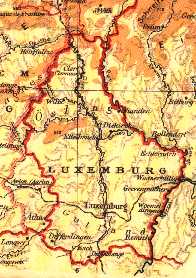
Luxemburg is a small country, with an area of merely 2586 km2. From north to south the length is about 80 km, from east to west about 50 km. The number of inhabitants is about 350.000. The distribution of the population is not evenly spread over the country. In the city of Luxemburg (situated only 15 km from the south border of the country) live about a quarter of the inhabitants. This city has a supporting function for all of the country. Beside this city there are some smaller cities like Esch sur Alzette (30.000 inh), Differdange (20.000 inh), Dudelange (15.000 inh) and Pétange (12.000 inh) all in the south. North of the city of Luxemburg there are some smaller cities like Ettelbrück, Diekirch and Wiltz. The official languages are German and French, but people also speak the so called Luxembourgian.
From the time of Napoleon (1815) the country is a great-dukeness. The Dutch king William I became duke in 1815. In 1831 Luxemburg lost some parts of the country around Arlon and Bastogne to Belgium. From that time it has the present size. After William I also William II and William III (all Dutch kings) were duke of Luxemburg. When William III died in 1890 the Dutch queen Wilhelmina should become his successor. But the constitution of Luxemburg only allowed a man, and not a woman, to be the monarch. So Adolf von Nassau (Adolf I) became duke. In 1905 he was succeeded by Wilhelm IV. Later on, when the constitution was changed also a women became monarch.
Real wars did never happen in the country. In the French-German war of 1870 the country remained neutral. Officially Luxemburg remained also neutral in the First World War of 1914-1918 (with an own government), but it was occupied by Germen troops. In the Second World War of 1940-1945 the country was also occupied by Germany. As we will see later on these wars of the surrounding countries had a great influence to the exploitation of railways of Luxemburg.
Until short there were many treasures of the soil in Luxemburg. In the south iron ore could be found. These areas can be considered as a part of the mining sites in Lotharingen (France) and Saarland (Germany). The winning of iron ore had also a great influence to the railways of the country.
Plans for constructing a railway line in Luxemburg existed already very early. In 1845 an English company asked permission to open several lines in the country with the city of Luxemburg as a central point. But as with many of the plans of these days, the money lacked to realize it.
From Belgium there came more serious plans. A line should be constructed from Brussels over Namur, Arlon to Luxemburg. This line could be extended to Trier in Germany and to Metz in France. The king approved of these plans, but in this case the financials remained the stumbling-block. You should realize that the number of inhabitants in the Ardennes is not so large; the number of travellers would be evenly small.
In Belgium (Brussels-Namur-Arlon) and in France (Nancy-Metz) lines were built in the direction of Luxemburg. But when the first plans came to connect these lines with each other, it looked as if the railway would by-pass the city of Luxemburg. A link from Arlon via Longwy to Metz would give the shortest route. The Luxembourgian government tried to change this of course. And in 1855 it looked as if the line would be laid via Luxemburg. But the government wanted more. A line to the north (in the direction of Liège or Aachen) and a line to Trier was something she also wanted. The government got in touch with existing railway companies as well in Germany as in France, but this had no result.
Only when the plans of private sector (by means of banker Adolf Favier and engineer Jouve, both from France) got sufficient certainty, the plans became definitive. The government had promised advance money to them, and would take part in the (high) cost of the severe passage through the city of Luxemburg. Only after these securities Favier and Jouve were willing to build a railway network in Luxemburg. Because of the positive influence of the duke William, the company was called the "William-Luxemburg railway".
Soon after the start it appeared that the gentlemen Favier and Jouve were not as gentlemanly as was thought first. Already in 1859 (that is before the opening of the first line) the WL had financial problems. After buying out these gentlemen and an extra contribution by the Luxembourgian government to the high building cost there could be built the rest of the line.
In 1859 the first line was opened, from Arlon in Belgium to Luxemburg, and further on to Metz in France. Some years after also other lines were opened by the WL-railways (to read a summary of the lines and date of opening or to see a map of Luxemburg and the railways/tramlines, see a separate web-page).
The WL-company was now in the hands of the government of Luxemburg. The daily working of the railways was in the first instance done by connecting foreign lines. On the line Luxemburg-Arlon by the CGL (Compagnie-Grand-Luxemburg from Belgium), on the line Luxemburg-Wasserbillig-Trier by the KPE (Königlich-Preussische Eisenbahn), and on other lines (the line to France, but also on the north line) by the Chemin de Fer de l'Est East railway from France).
In 1870 the French-German war broke out. This war was nothing of the business of the country of Luxemburg. But soon after the armistice it appeared that Germany had occupied the part of Elsas-Lotharingen from France. The railways in that part would from then on be worked by the "Reichs-Eisenbahnen in Elsas-Lotharingen", a German company. It would be obvious that this German company would also run the lines in Luxemburg, and so it happened. It appeared that there was much maintenance outstanding. Some lines were so bad, that re-building would be necessary. The Germans worked fast on this, so in quick time the lines in Luxemburg became in a reasonable state.
In 1914 again a war broke out. This time the First World War. As we all know peace came after 4 years, this time with victory for France. That what happened in 1870, happened also in 1918, but then the other way round. After victory of France, the Elsas-Lotharingen came again under France. The running of the railways came also under France. And as a consequence of this, the running of the railways in luxemburg was carried out by the French company the Ch.d.F.de Alsace-Lotharingen, later absorbed in the SNCF as we know it today.
In 1940 the history repeated itself for the third time. The country was occupied by Germany, and running of the railways went to the German Reichsbahn. This remained so until after the war. How it went further you can read in the next chapter 5.
Just another word about rolling stock in Luxemburg of the William-Luxemburg company. This company was only a owning company. She had no rolling stock of her own. The rolling stock was provided by the running companies. Until 1870 a French, from 1870 till 1918 a German, from 1918 till 1940 a French and from 1940 on again a German company. The lines in Luxemburg were only a small part of these companies. The rolling stock was only a part of the rolling stock of these companies. Never there was a defined part of the rolling stock specially for Luxemburg. It could happen that in one month 10 locs of series X were in the country, but a month later it could be 10 other locs of the same series or 6 locs of another series. To say something about rolling stock in the country of Luxemburg one should make a special study of rolling stock of these running companies, something far beside the scope of this article.
Soon after the opening of the lines of the William-Luxemburg railway it appeared, that the mining areas in the south of the country were bringing much profit. Because of this, several initiatives came to be to build a second railway network. The expected amount of goods transport for the mines led to these initiatives. In 1868 such an initiative came from Belgium. Mr.Philippard, director of the railway company "Société des Bassins Houillers du Hainault" (a mining railway in Hainault in Belgium) offered to build a second network. He proposed the following lines:
The last mentioned line gave problems with the concession in Prussia, so this line from Bettembourg via Remich to Germany never was build. The other lines were built from 1873 on. Phillippart proposed that he did not need any subsidies from the government. As compensation for building the lines he became concessions to do iron ore mining on a number of hectares. The name of the new company was chosen to be "Prince Henry" railway and mining company, named to the Dutch Prince Henry who supported the line.
In 1874, in the time of the building of the first PH-lines, the Belgium company "Société des Bassins Houillers du Hainault" got into financial problems. The mismanagement of director Phillippart was one of the reasons. The PH-railways also suffered under this financial crisis. After long negotiations, with which even a French railway company was involved, the Luxemburg government took financial responsibility for the company. She accepted eventual losses. But the government was not going to work the lines. At last the finances were acceptable and an limited company was established who would work the lines. Most of the shares remained in possession of Belgian shareholders. To enlarge the return on capital, some extra concessions for mining were granted to the company. There was also given a new concession to build a second line to the north of the country of Luxemburg from Noerdange (in the west of the country) to Troisvierges (in the upper north of the country). This line would be a competitor for the northern line of the William-Luxemburg railway. But this second northern line never has been built.
For a summary of all the lines and dates of opening or a map of Luxemburg with railways and tramlines, see a separate webpage.
The PH-railway always got a large part of its money from the mining. We can understand that if we look to the situation of the lines in the south of the country. In connection with the PH-lines many ore-loading stations were created. The line from Esch via Belval, Pétange and Rodange was a lucrative one. Transport of iron ore to the north and transport of coal from the north to the blast-furnaces in south of Luxemburg took place via this line and the westerly situated ring line Ettelbrück-Pétange. Around 1900 there was a large discussion about a new line from Luxemburg to Pétange between PH and WL. When the WL would succeed in getting the concession for this line, it would give much competition with the PH and the transport over the Attert line would diminish in favour of WL. At least the PH got permission to build a direct line from Pétange to Luxemburg.
Beside the exploitation of the before mentioned lines, the PH also worked several narrow gauge lines in the country (see chapter 8).
The rolling stock of the PH was owned by this company itself, this in contrast with the William-Luxemburg railway (see chapter 3). The Belgium influence could be seen clearly. Much of the rolling stock was made in Belgium and was look alike to other Belgian stock.
The outbreak of the second world war resulted in the end of the PH. The German troops ordered that the property of the PH-railway was passed to the government. The exploitation was done from 1 december 1940 by the Deutsche Reichsbahn. How it came out with the PH, we can read in the next chapter.
Already in the Second World War the two Luxembourgian railway companies as described before, (the William-Luxemburg-Railway, see chapter 3, and the Prince-Hendrik-Railway, see chapter 4) were combined by the German government. During the war there was only one company to run the railways in Luxemburg, the German Reichsbahn.
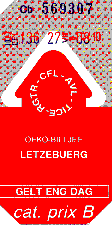
In times of the liberation of the country much damage was done to the railway network of the CFL. Especially the northern line, north of Ettelbrück, was not immediately usable. The rolling stock that was present on the moment of liberation was of poor quality. The last operator of as well the WL-railway as the PH-railway (the German Reichsbahn) was not able to begin running after the days of liberation. Besides that, the government of Luxemburg was not willing to accept the DR as operator. But the French Ch.d.F.de l'Est (operator in Alsace-Lorraine) did not display much interest to work the railway in Luxemburg. The government of Luxemburg first had to repair the damages to the railroad. Especially the bridges in the country and the railway yard of Luxemburg were severely damaged.
On 14 may 1946 the CFL was founded. Both networks, as well that of the William-Luxemburg and that of the Prince-Hendrik railways were amalgameted into one network. The first task of the new company was of course the rebuilding of a good railway network. The damaged bridges were as good as was possible shortly after the war temporarily repaired, but to the rest of the railways a large maintenance in arrear did occur. The rolling stock with which the CFL started was also a hotchpotch of different stock. It existed of war-booty from Germany, but also old rolling stock of French railways and stock from different other countries (even from Czechoslovakia and Poland) was available.
In the beginning of the years '50 a start was made with modernization of the rolling stock. New stock was ordered. Also electric stock, this in relation to the electrification of a part of the network end years '50. To see a description of the rolling stock, see the separate web-page.
Halfway the years '50 it appeared soon, that a positive exploitation of the Attert-line and the Sure-line (both before the war property of the PH-railway) was no more possible. Closing these lines followed for passenger transport in 1954 (Attert-line Pétange-Ettelbrück) and 1964-1967 (the line Diekirch-Echternach-Wasserbillig).
Modernization on other lines came soon. Recently the north-line from Luxemburg to Gouvy and Liège in Belgium has been modernized. The control of train-service and control of switches has been more and more centralized. About plans for the near future you can read something more in chapter 11.
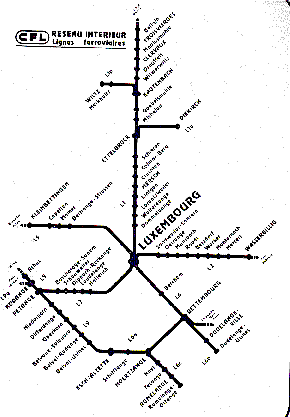
Luxemburg is a small country, with the large city Luxemburg as a spider centrally positioned in the web of railway lines. From the city Luxemburg there are lines to all parts of the country. With exception of a few yards all lines have been meanwhile electrified. The line from Luxemburg to Kleinbettingen and Arlon in Belgium with 3.000 V direct current, the rest of the lines with 25.000 V 50 Hz alternating current.
The following railway lines can be seen today in Luxemburg (for a complete description of railway lines and stations, see the summary of railway lines in Luxemburg or the map of Luxemburg with railways and tramlines).
To the northBeside these lines there has been in the past a ring railway from Pétange in the southwest, over Kleinbettingen, Noerdange and the valley of the Attert to Ettelbrück. Further on there was a line from Diekirch over Echternach to Wasserbillig and further on to Grevenmacher in the east.
For a small country of course it is not possible to develop rolling stock itself, something that railway companies in larger countries mostly do. Because of this most of the rolling stock is a copy of foreign stock. In times of the first electrification (1959) there came 20 electric locs (series 3600). Today they are no more present; they recently have been replaced by new locs of the series 3000 and locs of series 4000.
About diesel locs, there were two series of locs of the series 1600 and 1800 (both delivered end years '50). Both series have gone now. In the year 2000 there have come some new diesel locs in lease from Siemens. Since the electrification of the northern line (1996) most transport is done by means of electric railcars and trains are operated by the electric locs or by railcars.
About shunting locs, there is more to see. The series 800/850/900 with medium power were ordered but today they are no more in service. Besides there are some smaller locs used for shunting small quantities of goods wagons and for help trains. Since the year 2000 there are also some other large diesel locs in Luxemburg available. Further on there have come several locs to the CFL because of the amalgamation of CFL-cargo and Arbed railways. The before Arbed diesel locs are now part of CFL-cargo.
When spoken about electric railcars, there were six two-wagon railcars (series Z 251-256), two three-wagon railcars (Z 261-262), 21 newer two-wagon railcars (series 2100), and a lot of double-decked railcars (series 2200 and 2300). In the past there has been also some newer diesel railcars, but today (as all of the network has been electrified) they are no more in the country.
In the past there have been serveral series of diesel railcars. Rail buses just as in Germany, and also rail cars as in France. Because there are no more non-electrified lines in the country, all diesel railcars have vanished today.
Since end fifties there have been coaches delivered by Wegmann. They have long been in service, in 2005 and 2006 replaced by double stocked coaches which are pulled by the new locs of the series 4000.
For a summary of all locomotives, railcars and coaches in Luxemburg, see the separate web-page.
In the country of Luxemburg there have been several narrow gauge railway lines. Besides the city tramlines in Luxemburg and city tramways around Esch s.Alzette there have also been narrow railways in the countryside (to see a map of Luxemburg with tramlines, see a separate webpage). All of these tramlines have been worked with steam and later on some motor cars. These lines all were single track, and had a rail gauge of 1000 mm. The next lines could be found:
In the country of Luxemburg apart from the before described narrow gauge railways there existed also two networks of city tramways. Nothing can be seen of them today, although a new tram line has been made in the city of Luxemburg.
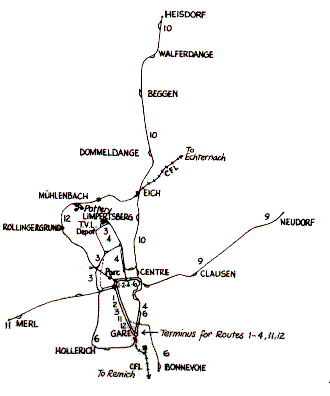
In the city of Luxemburg from 1875 until the years '50 there existed a network of some 10 tramlines. On 20 febr 1875 the first tramline, a horse tram, was opened from the station to (after some prolongations) the Rond Point Schuman in the north of the city. With about 50 horses this tramway remained the only horse tram in the city.
In 1904 the steam tramway from Luxemburg station via the Rollingergrund and Eich to Echternach was opened. In 1926 this line was partly closed, partly electrified (between Luxemburg station and Dommeldange) and integrated in the city tram network. For a description of the countryside tramways look in chapter 8.
From 8 august 1908 in the city of Luxemburg an electric meter gauge tramline from 8.6 km length came into exploitation with the T.V.L. (Tramways de la Ville de luxemburg). This line consisted of a ring line from the station (south of the city), via the Limpertsberg (in the north west of the city) via the Pont Adolphe back to the railway station. In 1913 a second line was opened to Eich and Dommeldange in the north. Later on this line was extended to Walferdange and Heisdorf. In the south there came also tramlines to Hollerich, Merl and Bonnevoie; in the east there was branch via Clausen to Neudorf and in the west there was a line via the Rollingergrund to Eich (in the Alzette-valley near Dommeldange). In Eich there was connection to the rural tramline to Echternach. The city tramway of Luxemburg reached the biggest length just before the Second World War with 31 km length. After the war tramlines were converted to busses. From 1952 on several lines were closed, until on 5 sept 1964 the last line to Eich, Dommeldange and Walferdange was closed. Together there have been 47 tram motorcars and 29 lorries, most of them with two axles, some with three axles and two motorcars with four axles.
For a more intensive description of the city tram of Luxemburg, see my separate website about the historical city tram of Luxemburg, or my separate website about the tramline in Luxemburg of today.
In the neighborhood of Esch-sur-Alzette there also has been an extended network of tramways. These tramways connected the city of Esch to the west with Belval, Soleuvre, Differdange, Pétange and Rodange, and to the other side of Esch in the east with Kayl, Rumelange and Dudelange. The lines have been built between 1927 and 1931, all were electrified, and were closed between 1949 and 1956. More about these lines can be found on the separate webpage about the tram in Esch-sur-Alzette.
As has been said in the introduction, in the country of Luxemburg in the past there were areas where iron ore was found. In the south of the country along the border with France (Dudelange, Esch s.Alzette) rich iron ore mines were present. In the second half of the 19th century the first blast-furnace was erected near these mines. Because the transport of iron ore and coal (to heat the blast-furnace) should be carried in the beginning by horse and cart, the mining was only on a small scale. Only when railways made it possible to transport ore and coal faster and on a larger scale, steel fabrication became more and more possible. Blast-furnaces were erected in several places (Dudelange, Schifflange, Esch s.Alzette, Differdange, Pétange, Rodange, Dommeldange, Steinfort, and perhaps more).
In the hills in the south of the country many iron ore loading stations were built, from which the iron ore could be transported to the blast-furnaces in (and also outside) Luxemburg. Partly this happened with normal gauge railway wagons over lines of the PH-railway (around Pétange in the west and from the hills near Rumelange and Dudelange in the south). For another part there were also narrow gauge lines (mostly 700 mm gauge) from the hills south of Esch to Belval and Schifflange, and from the hills at Lasauvage (west of Differdange) to Differdange. In some places, like on the platform of the railway station of the city Esch sur Alzette, some narrow gauge ore lorries can be seen today as a statue.
In most cases coal was imported from abroad. Partly from Antwerp by train, from the area around Aachen in Germany, and later on via Mertert (in the Moselle) by boat, where it was transshipped into railway wagons.
In the years of '70 one could see another strange transport. From the blast-furnace in Belval (west of Esch s.Alzette) liquid iron was transported by special wagons (with 16 axles) to Dudelange, more than 15 km over public railways (the CFL). It gave literally a warm feeling to see such a huge wagon with tons of liquid iron come besides the railway platform.
In the course of years most companies of the blast-furnaces have been amalgamated. In the country there is nowadays one large organization, for a long time under the name Arbed, and todays under the name Arcelor-Mittal. This is an international concern, which works the steel factories. Today iron ore no longer can be found in the country of Luxemburg; the now present iron ore mines do no longer pay off. From the blast-furnaces and steel-factories not as much has been left as say ten or twenty years ago. But you can still see a lot. In Belval (west of Esch s.Alzette), Schifflange (east of Esch-sur-Alzette), Differdange and in Rodange (in the west near the French border) there are still steel factories working.
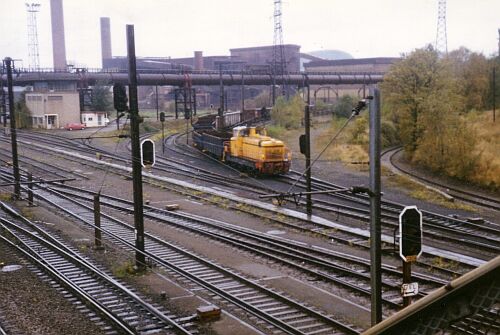
When speaking about railways of the steel factories, today there is less to be seen then for some years ago. For some years ago there were factories in Schifflange, in Belval, in Differdange and in Rodange. Today many have been closed, only around Differdange and around Belval you can see some remains. On the site of these factories there was an extended network of railways. Several factory owned locs (mostly diesel) could be seen. There were four axled heavy locs (sereis 300 of the ARBED which still can be seen), furthermore there were two-axled locs (series 1-20).
In 1965 the blast-furnaces and rolling-mill in Differdange was taken over by the Arbed. These factories are situated about 5 km away from the blast-furnace in Belval, on that time the most modern one of the Arbed. To make intern transport between Belval and Differdange more flexible, on 4 march 1974 a factory owned railway was opened. This single tracked line runs in a tunnel under Mount Soleuvre. There have been advanced plans to extend this line to Pétange (another 4 km more to the north) to be used not only by ARBED owned trains, but also by public transport of the CFL. This line should replace the line of the CFL via Differdange and the hills in the south to Esch. The shorter distance and the absence of sharp curves and steep gradients as are present in the old line would be an advantage for the CFL for throug going goods transport. The old line from Differdange via Oberkorn and Belval would be abandoned in this plans. As a result of the crisis in the steel sector nothing was done with the plans. This was also, because the CFL would not accept the loss of passengers transport of the old line. In 1984 it was decided to leave things as they were and to invest in the old line. Later in the years '80 a motorway has been constructed on the already constructed ground works of the new line. A short part of the new line was built, and is now in use for transport from Esch-Belval to the factories east of Dommeldange.
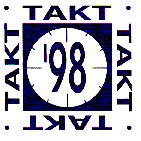
At the beginning of the summer of 1998 the CFL has introduced a new train service "Takt '98". In this service many new throug going services at the city of Luxemburg were introduced. From lines north of the city (from Wiltz, Diekirch and Wasserbillig) trains run through to the south of the country (Bettembourg, Esch, Rodange). Besides that, the number of trains has been increased. Today this through going trains through Luxemburg station have partly been abandoned, I think it was because the risk on delays was too big. But the increased number of trains has remained, especially on the north-line to Ettelbrück and Kautenbach and on the line from Luxemburg via Bettembourg, Esch s.Alzette to Rodange.
This new train service could be only an indication of things that will happen in future. Advanced plans have existed to combine train and tram (like in Karlsruhe or Saarbrucken) in the city of Luxemburg. In these plans trains from north and south of the country would ride further on through the streets of the city of Luxemburg as tramlines. over the Pont Charlotte (the large red bridge over the Alzette valley in Luxemburg) to the Kirchberg and to Dommeldange. These plans have not been taken to reality.
But the tram plans in the city of Luxemburg has taken another way. The plans of the tram to the Kirchberg plateau north east of the city have been made reality. A new tramline from the central station, via the city center and over the Pont Charlotte to the Kirchberg plateau, has been opened some years ago. The tramline will be extended to the southern part of the city of Luxemburg.
For the railways new plans were made of which several are now taken into reality.
Who wants to read something more about railways in Luxemburg, several books can be found. The books are mentioned on the subpage of books.